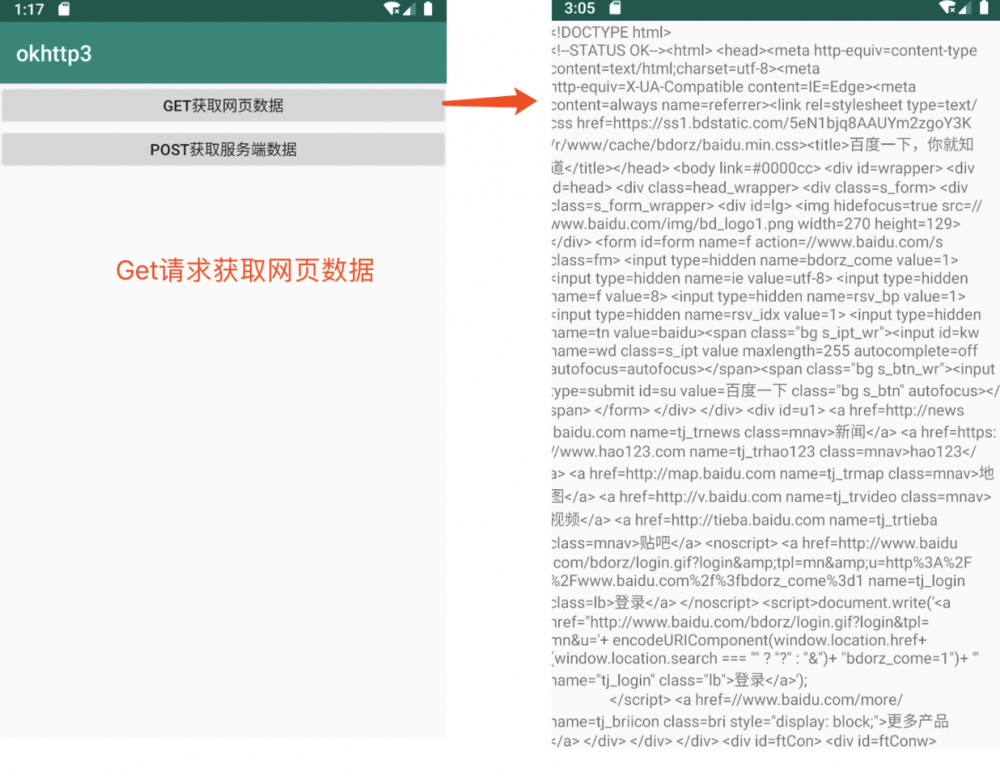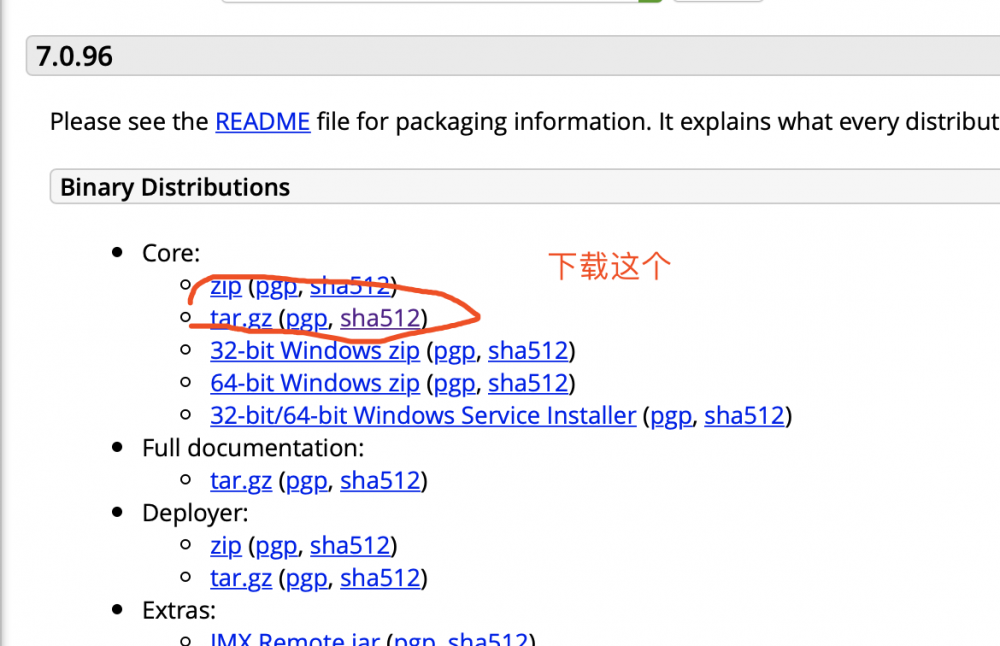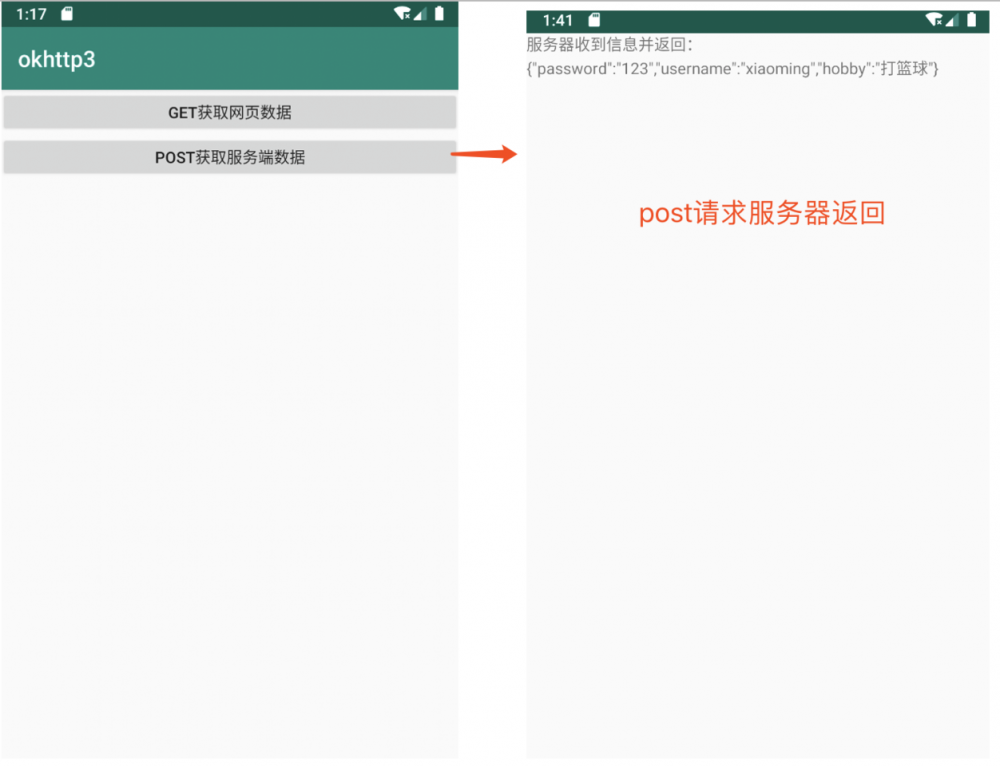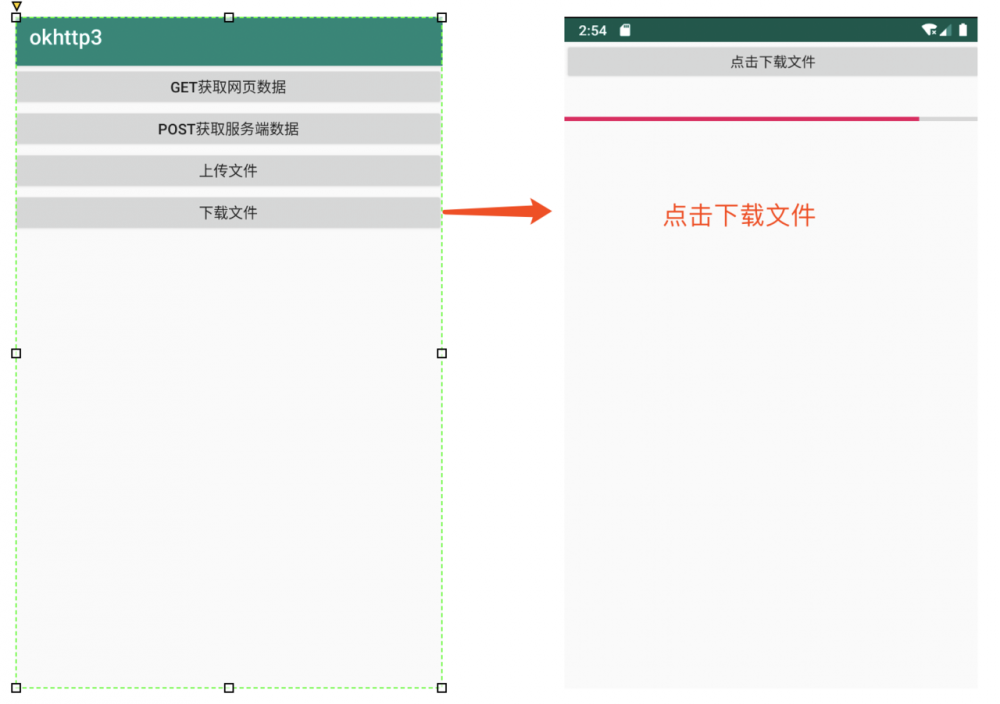一文了解OKHttp3全
okhttp3现在基本都在用的一个底层网络框架。这篇博客主要的目的就是将OKHttp3这个框架在开发中能用到的地方都记录下来,也当一个工具文档为日后使用时查找方便。
2.环境搭建
首先记得在build.gradle 和 配置文件分别加上依赖和网络权限
implementation 'com.squareup.okhttp3:okhttp:3.8.0' implementation 'com.squareup.okio:okio:1.12.0' 复制代码
以及权限
<uses-permission android:name="android.permission.INTERNET"/> 复制代码
完事了,接下来介绍使用
3.Get使用

OkHttpClient mClient = new OkHttpClient.Builder() // 构建者模式,创建实例 .connectTimeout(20, TimeUnit.SECONDS) // 设置连接超时时间 .build(); Request mRequest = new Request.Builder() // 构建者模式,创建请求信息 .get() .url("https://www.baidu.com") .build(); Call call = mClient.newCall(mRequest); // 将request转换成call call.enqueue(new Callback() { // 执行call @Override public void onFailure(Call call, IOException e) { } @Override public void onResponse(Call call, Response response) throws IOException { final String strByNet = response.body().string(); // 切换到主线程 runOnUiThread(new Runnable() { @Override public void run() { tv_msg.setText(strByNet); } }); } }); 复制代码
好了,这就是get的简单使用,不过说了是工具,自然要列出扩展 OkHttpClient.Builder的扩展属性
* final Dispatcher dispatcher; //重要:分发器,分发执行和关闭由request构成的Call * final Proxy proxy; //代理 * final List<Protocol> protocols; //协议 * final List<ConnectionSpec> connectionSpecs; //传输层版本和连接协议 * final List<Interceptor> interceptors; //重要:拦截器 * final List<Interceptor> networkInterceptors; //网络拦截器 * final ProxySelector proxySelector; //代理选择 * final CookieJar cookieJar; //cookie * final Cache cache; //缓存 * final InternalCache internalCache; //内部缓存 * final SocketFactory socketFactory; //socket 工厂 * final SSLSocketFactory sslSocketFactory; //安全套接层socket 工厂,用于HTTPS * final CertificateChainCleaner certificateChainCleaner; // 验证确认响应证书 适用 HTTPS 请求连接的主机名。 * final HostnameVerifier hostnameVerifier; // 主机名字确认 * final CertificatePinner certificatePinner; // 证书链 * final Authenticator proxyAuthenticator; //代理身份验证 * final Authenticator authenticator; // 本地身份验证 * final ConnectionPool connectionPool; //连接池,复用连接 * final Dns dns; //域名 * final boolean followSslRedirects; //安全套接层重定向 * final boolean followRedirects; //本地重定向 * final boolean retryOnConnectionFailure; //重试连接失败 * final int connectTimeout; //连接超时 * final int readTimeout; //read 超时 * final int writeTimeout; //write 超时 复制代码
4.服务器搭建
为了测试接下来的功能,我们自己搭建一个服务器。 先搭建环境,配置tomcat 作者的是mac所以就介绍下mac下配置tomcat的方式,Windows的小伙伴们可以参考这个( www.cnblogs.com/beginner-bo… )
- 下载Tomcat

- 下载文件解压

-
打开终端输入命令,简单办法,终端输入cd,然后直接将bin文件夹直接拖拽到终端
-
cd /Library/Tomcat/bin
-
将目标文件授权,终端输入命令
chmod +x *.sh
-
启动tomcat
./startup.sh
-
浏览器中输入: http://localhost:8080/

到这里,恭喜你tomcat配置成功
服务端作者使用的是IDEA,怎么在这里面配置Tomcat,以及后面要使用的Servlet可看这个文章,会用的小伙伴可以跳过( www.cnblogs.com/wfhking/p/9… )
好了,到这里,服务端已经搭建完毕,接下来,我们书写服务端程序吧!
4.post使用

服务端
@WebServlet(name = "TestPost") public class TestPost extends HttpServlet { protected void doPost(HttpServletRequest request, HttpServletResponse response) throws ServletException, IOException { response.setHeader("Access-Control-Allow-Origin", "*"); // 跨域 response.setContentType("text/html"); // 设置响应内容类型 response.setCharacterEncoding("UTF-8"); // 指定编码 // 获取前端传入的数据 BufferedReader br = request.getReader(); String line; StringBuffer mStringBuff = new StringBuffer(); while ((line = br.readLine()) != null){ mStringBuff.append(line); } //设置逻辑实现 PrintWriter out = response.getWriter(); String jsonStr = "服务器收到信息并返回:/n" + mStringBuff.toString(); out.println(jsonStr); } protected void doGet(HttpServletRequest request, HttpServletResponse response) throws ServletException, IOException { } } 复制代码
好了,这样就行了,接下来继续实现我们的客户端的post
客户端
private void doPost(String username, String pass, String hobby) { // 编码集 final MediaType FORM_CONTENT_TYPE = MediaType.parse("application/json; charset=utf-8"); // 接口地址 final String uri = "http://192.168.0.102:8081/TestOkhttp3_war_exploded/TestPost"; // 创建实例 OkHttpClient okhttp = new OkHttpClient.Builder() .build(); // 创建表单及数据 HashMap<String, String> map = new HashMap<>(); map.put("username", username); map.put("password", pass); map.put("hobby", hobby); String jsonStr = new Gson().toJson(map); RequestBody formBody = RequestBody.create(FORM_CONTENT_TYPE, jsonStr); // 创建请求实例 Request request = new Request.Builder() .url(uri) .post(formBody) .build(); Call call = okhttp.newCall(request); call.enqueue(new Callback() { @Override public void onFailure(Call call, IOException e) { Log.e("lybj", "接口调用失败"); } @Override public void onResponse(Call call, Response response) throws IOException { final String strByNet = response.body().string(); // 切换到主线程 runOnUiThread(new Runnable() { @Override public void run() { tv_msg.setText(strByNet); } }); } }); } 复制代码
当然这么写了之后,会出现一个异常
CLEARTEXT communication ** not permitted by network security policy 这是因为,Android高版本后限制了HTTP访问权限。
解决方案有2个,要么采用https,要么采用下面的方法 在res里面新建xml文件夹,创建文件network_security_config.xml
<?xml version="1.0" encoding="utf-8"?>
<network-security-config>
<base-config cleartextTrafficPermitted="true" />
</network-security-config>
复制代码
在application中引用它
<application
...
android:networkSecurityConfig="@xml/network_security_config">
复制代码
ok了,post可以正常使用了
5.post上传多文件和参数

在project settings -> Artifacts -> 选择自己的工程 -> 右边OutPut directory 中看到自己的输出路径,然后找到该路径,可查看到自己提交的文件及控制台输出的参数信息。

服务端
protected void doPost(HttpServletRequest request, HttpServletResponse response) throws ServletException, IOException { // 设置编码 request.setCharacterEncoding("UTF-8"); response.setContentType("text/html;charset=UTF-8"); PrintWriter pw = response.getWriter(); try { // 设置系统环境 DiskFileItemFactory factory = new DiskFileItemFactory(); // 文件存储的路径 String storePath = getServletContext().getRealPath("/WEB-INF/files"); if(!new File(storePath).exists()){ new File(storePath).mkdirs(); } ServletFileUpload upload = new ServletFileUpload(factory); upload.setFileSizeMax(4 * 1024 * 1024); // 设置单个文件大小不能超过4M upload.setSizeMax(4 * 1024 * 1024); // 设置总文件上传大小不能超过6M // 解析 List<FileItem> items = upload.parseRequest(request); for (FileItem item : items) { // 普通字段,表单提交过来的 if (item.isFormField()){ String name = item.getFieldName(); String value = item.getString("UTF-8"); System.out.println(name + "==" + value); } else { // 解析上传的文件 // String mimeType = item.getContentType(); 获取上传文件类型 // if(mimeType.startsWith("image")){ InputStream in = item.getInputStream(); String fileName = item.getName(); if (fileName == null || "".equals(fileName.trim())) { continue; } fileName = fileName.substring(fileName.lastIndexOf("//") + 1); fileName = UUID.randomUUID() + "_" + fileName; // 按日期来建文件夹 String storeFile = storePath + "/" + fileName; OutputStream out = new FileOutputStream(storeFile); byte[] b = new byte[1024]; int len = -1; while ((len = in.read(b)) != -1) { out.write(b, 0, len); } in.close(); out.close(); item.delete(); // 删除临时文件 } } PrintWriter out = response.getWriter(); out.println("上传成功"); } catch (org.apache.commons.fileupload.FileUploadBase.FileSizeLimitExceededException e) { pw.write("单个文件不能超过4M"); } catch (org.apache.commons.fileupload.FileUploadBase.SizeLimitExceededException e) { pw.write("总文件不能超过6M"); } catch (FileUploadException e) { e.printStackTrace(); } } 复制代码
客户端
/** * 上传文件 * */ private void doUpload(File file, String userId, String msg){ // 接口地址 OkHttpClient client = new OkHttpClient.Builder() .connectTimeout(30, TimeUnit.SECONDS) .build(); RequestBody fileRequestBody1 = RequestBody.create(MediaTypeUtils.UPLOAD_FILE.value, file); // 可传多个 MultipartBody body = new MultipartBody.Builder() .setType(MultipartBody.FORM) .addFormDataPart("userId", userId) .addFormDataPart("msg", msg) .addFormDataPart("file", "myFileName", fileRequestBody1) .build(); Request rb = new Request.Builder() .header("Authorization", "Client-ID " + UUID.randomUUID()) .url(ApiUtils.TestPostUpload) .post(body) .build(); Call call = client.newCall(rb); call.enqueue(new Callback() { @Override public void onFailure(Call call, IOException e) { Log.e("lybj", "接口调用失败"); } @Override public void onResponse(Call call, Response response) throws IOException { final String string = response.body().string(); runOnUiThread(new Runnable() { @Override public void run() { tv_msg.setText(string); } }); } }); } 复制代码
接口封装了下
public interface ApiUtils { String BaseUri = "http://192.168.0.102:8081/TestOkhttp3_war_exploded/"; // post提交json String TestPost = BaseUri + "TestPost"; // 上传文件 String TestPostUpload = BaseUri + "TestPostUpload"; } 复制代码
定义一个枚举类型,用于存储上传使用的信息
public enum MediaTypeUtils { JSON_UTF_8(MediaType.parse("application/json; charset=utf-8")), // 设置Json数据传输并指定Utf-8为编码集 UPLOAD_FILE(MediaType.parse("multipart/form-data")); // 上传文件 public MediaType value; MediaTypeUtils(MediaType value) { this.value = value; } } 复制代码
好了,这就可以了
6.post下载
简单起见,我们直接下载个网上的APK 
客户端
/** * 下载文件 * */ private void doDownload(){ // 接口地址 OkHttpClient client = new OkHttpClient.Builder() .connectTimeout(60, TimeUnit.SECONDS) .build(); Request rb = new Request.Builder() .get() .url(ApiUtils.TestPostDownload) .build(); Call call = client.newCall(rb); call.enqueue(new Callback() { @Override public void onFailure(Call call, IOException e) { Log.e("lybj", "接口调用失败"); } @Override public void onResponse(Call call, Response response) throws IOException { writeFile(response); } }); } 复制代码
/** * 下载文件 * */ private void writeFile(Response response) { InputStream is = null; FileOutputStream fos = null; is = response.body().byteStream(); String path = Environment.getExternalStorageDirectory().getAbsolutePath(); File file = new File(path, "hehe.apk"); try { fos = new FileOutputStream(file); byte[] bytes = new byte[1024]; int len = 0; // 获取下载的文件的大小 long fileSize = response.body().contentLength(); long sum = 0; int porSize = 0; while ((len = is.read(bytes)) != -1) { fos.write(bytes); sum += len; porSize = (int) ((sum * 1.0f / fileSize) * 100); Message message = handler.obtainMessage(1); message.arg1 = porSize; handler.sendMessage(message); } } catch (Exception e) { e.printStackTrace(); } finally { try { if (is != null) { is.close(); } if (fos != null) { fos.close(); } } catch (IOException e) { e.printStackTrace(); } } Log.i("myTag", "下载成功"); } 复制代码
Handler handler = new Handler() { @Override public void handleMessage(Message msg) { if (msg.what == 1) { pro.setProgress(msg.arg1); } } }; 复制代码
好了,到了这里,下载也OK了,上传和下载之前,别忘记动态申请Android权限哈。
7.Gzip压缩
为了优化(扯淡的故事)接口要求压缩上传的数据,好了直接贴代码
build.gradle
implementation 'com.zhouyou:rxeasyhttp:2.1.2' 复制代码
OkHttpClient client = new OkHttpClient.Builder() .connectTimeout(60, TimeUnit.SECONDS) .addInterceptor(new GzipRequestInterceptor()) .build(); 复制代码
当然,需要服务器支持,OK,完事了
- 本文标签: XML 连接池 windows client tar API ACE parse IO 服务器 参数 stream ip map ECS CTO queue json equals tab build IDE Word 解析 cache web 文件上传 retry tomcat 主机 安全 域名 message 实例 HashMap 测试 Connection DNS 数据 博客 Android ORM apache list 缓存 servlet src cat 时间 下载 Select id 协议 final rand js UI 删除 HTML Security zip value Proxy db lib 线程 代码 文章 DOM 服务端 ssl 开发 tag https 配置 http App Authorization rmi
- 版权声明: 本文为互联网转载文章,出处已在文章中说明(部分除外)。如果侵权,请联系本站长删除,谢谢。
- 本文海报: 生成海报一 生成海报二











![[HBLOG]公众号](https://www.liuhaihua.cn/img/qrcode_gzh.jpg)

